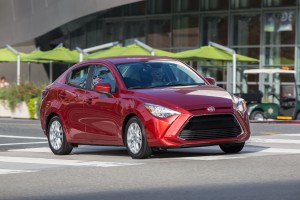
The 2016 Scion iA was the youth-oriented brand's first-ever sedan and one of two products parent Toyota hoped would save the brand.
It was intended to attract the sort of hip young buyers who were largely steering clear of Toyota stores, and, for at least a few years, it worked. But with sales steadily dropping despite an infusion of new product, Toyota is pulling the plug on its Scion brand.
Products like the new Scion iM and iA won’t be abandoned, however. The plan is to rebadge them as Toyota products for the 2017 model-year, though it’s unclear what will happen to the edgy C-HR crossover vehicle that Scion was developing, as it could come to close to existing Toyota products.
“This isn’t a step backward for Scion; it’s a leap forward for Toyota,” said Jim Lentz, the CEO of Toyota North America, is a statement. “Scion has allowed us to fast track ideas that would have been challenging to test through the Toyota network.”
At least, that was the plan, and the way Scion operated in the early years after its launch in 2003. But industry analysts suggest that the brand made a series of mistakes, compounded by the seeming indifference of parent Toyota.
“It failed because it wasn’t supported the way it should have been,” said Stephanie Brinley, a senior analyst with IHS Automotive. “It needed constant product and attention to keep moving,” but it just didn’t get that.
In its original form, Scion was meant to be a brand-within-a-brand. Toyota decided not to ask dealers to set up separate showrooms but simply reserve a corner of their existing stores for the new marque. The idea was to introduce a running series of small, affordable – and intentionally quirky – products, such as the boxy xB that became an immediate hit, leading competitors to race to come up with their own versions.
Buoyed by the xB and other hot models, Scion sales peaked in 2006 at 173,034, and Scion had the youngest average owner age of any brand in the U.S. market. The hope was that as those buyers aged, they’d migrate to more mainstream – and pricey Toyota products.
(Automakers pairing up with the Internet of Things. Click Here to find out what that means for the future.)
The first mistake, many observers believe, was trying to come up with a second-generation xB. It went through too many consumer clinics, suggested analyst Brinley, and the new version was a dud. Other products that followed didn’t do much better.
And then the industry plunged into its worst recession in decades. Studies show that the young buyers Scion – and competitors — coveted were among those hardest hit financially. With “failure to launch” becoming more than a cliché, many Millennials decided to forego buying a car. Indeed, many didn’t even bother to get a driver’s license. And, even as the economy recovers, that trend is continuing.
A study released last week by the University of Michigan Transportation Research Institute showed that fewer young adults are getting drivers licenses than at any time in the last three decades. Among those aged 20 to 24, just three in four were licensed as of 2014, down from more than nine in 10 back in 1983.
(Study finds Millennials aren’t the only ones skipping their drivers’ licenses. Click Here for the story.)
By 2014, Scion sales had dipped to just 58,009 despite a long-delayed infusion of new products. In fact, the brand abandoned one of the key tenets of its original plan which was to limit it to just three models at any one time. While the failed xB was abandoned, along with the iQ minicar, Scion kept its tC coupe and FR-S sports car, and added two more models, the iM hatchback and the brand’s first-ever sedan, the iA.
Hoping to rebuild momentum, “We’re taking a look at everything we’re doing as a brand,” Scion General Manager Doug Murtha told TheDetroitBureau.com during a media preview in Grand Rapids, Michigan last summer.
But there were signs that Scion was still losing momentum, especially when 2015 sales dropped again, to 56,167, despite the overall surge in U.S. car sales.
The band pulled the plug on the sort of big-budget national concerts it once backed. And then, when the 2015 North American International Auto Show rolled into Detroit last month, there was no sign of the Scion C-HR. First revealed in concept form at the L.A. Auto Show in November 2015, a production version was widely expected to be revealed in Detroit.
Toyota has its own mini-crossover coming, so there’s little future for the C-HR, according to observers. The tC coupe will be dropped later this year. But the FR-S, iA and iM are likely to live on as Toyotas.
The failure of Scion isn’t the first time an automaker had to admit failure in an attempt to reach a youthful market. General Motors came up with a similar strategy for a brand it dubbed GEO. It marketed a mix of minicars sourced from GM affiliates such as Suzuki and Isuzu, and operated out of space in Chevrolet showrooms. But, after an initial burst, sales went into a tailspin and Geo was dropped in 1997.
(Toyota buying out small car brand Daihatsu. Click Here for the story.)



